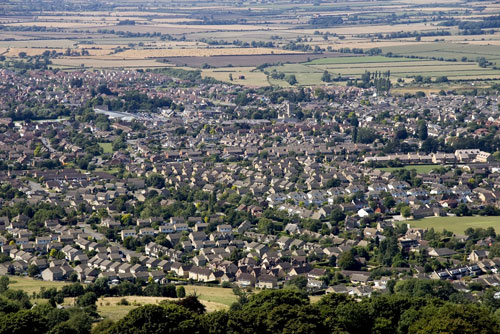Greenbelts and counterurbanisation
Greenbelt has not been fully accessible in its aim to restrict development in the countryside. In the 1940s and 1950s transport and communications in the countryside were poor. In the modern day transport and communications have improved so as to entice urban residents out past the suburbs and the greenbelt to commuter villages across the UK (Woods 2010).
As the UK road and motorway network has extended outward to link main towns and cities and a parallel increase in rate of car ownership has occurred (Lewis 1998), improved speed and access to urban areas from the countryside has been made possible. The result has been Counterurbanization.

'A view of a town or village seen from above ' / Shutterstock
Greenbelt policy in effect stopped suburbanisation in cities and yet the desire and motivation for urban residents to move out to less dense areas remained (Champion 2001). The outcome was that many have simply leapfrogged the greenbelt and relocated to villages in the commuter belt around major UK cities . It is now in these areas that the real battles between urbanisation and the countryside are arguably being fought to protect the remaining countryside and stop further development. Much of the resistance to change is coming from recent incomers seeking to protect their ‘rural idyll’ (Murdoch and Lowe 2003).
In extreme instances counterurbanization has led to the purchasing of second homes, particularly in areas of high scenic value or outdoor recreation, such as National Parks (Woods 2007). In these instances previously occupied homes in rural villages are not actually lived in for much of the year, but are there to provide ‘an escape’ from the stress of urban areas. However, perhaps the most familiar scenario is the suburbanisation of villages in the countryside to provide homes for high earning commuters in cities (Owen, Bishop and O’Keefe 2011).
The process is often begun by the purchasing and renovating of older properties in a village by high-earning buyers from urban areas. As a village finds itself in an evolving commuter zone of an urban area, the high demand for additional housing in the countryside leads to new housing being built on the outskirts of the village. The result is that the village becomes a dormitory settlement, with the focus of economic activity for the inhabitants during the day located elsewhere (Woods 2007). The character of the village changes profoundly.